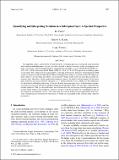| dc.contributor.author | Chen, Ru | |
| dc.contributor.author | Wunsch, Carl | |
| dc.contributor.author | Flierl, Glenn Richard | |
| dc.date.accessioned | 2015-08-04T18:28:49Z | |
| dc.date.available | 2015-08-04T18:28:49Z | |
| dc.date.issued | 2015-02 | |
| dc.date.submitted | 2014-10 | |
| dc.identifier.issn | 0022-3670 | |
| dc.identifier.issn | 1520-0485 | |
| dc.identifier.uri | http://hdl.handle.net/1721.1/98013 | |
| dc.description.abstract | The amplitude, origin, and direction of striations in the subtropical gyre are investigated using simulated and analytical multidimensional spectra. Striations, defined as banded structures in the low-frequency motions, account for a noticeable percentage of zonal velocity variability in the east North Pacific (ENP: 25°–42°N, 150°–130°W) and central North Pacific (CNP: 10°–22°N, 132°E–162°W) regions in an eddying global ocean model. Thus, they likely are nonnegligible in mixing and transport processes. Striations in the ENP region are nonzonal and are embedded in the nonzonal gyre flow, whereas striations in the CNP region are more zonal, as are the mean gyre flows. An idealized 1.5-layer model shows the gyre flow partially determines their directions, which qualitatively resemble those in the global eddying model. In the linear limit, structures are quasi-stationary (frequency ω → 0) linear Rossby waves and the gyre flow influences the direction by influencing the nature of the zero Rossby wave frequency curve. In the nonlinear regime, striations are consistent with the nondispersively propagating eddies, whose low-frequency component has banded structures. The gyre flow influences the striation direction by changing the eddy propagation direction. Their origin in the nonlinear regime is consistent with the existence of a nondispersive line in the frequency–wavenumber spectra. This study does not exclude other striation mechanisms from literature, considering that the interpretations here are based on an idealized model and only from a spectral perspective. | en_US |
| dc.description.sponsorship | United States. National Aeronautics and Space Administration (NNX09AI87G) | en_US |
| dc.description.sponsorship | United States. National Aeronautics and Space Administration (NNX08AR33G) | en_US |
| dc.description.sponsorship | United States. National Aeronautics and Space Administration (NNX11AQ12G) | en_US |
| dc.language.iso | en_US | |
| dc.publisher | American Meteorological Society | en_US |
| dc.relation.isversionof | http://dx.doi.org/10.1175/jpo-d-14-0038.1 | en_US |
| dc.rights | Article is made available in accordance with the publisher's policy and may be subject to US copyright law. Please refer to the publisher's site for terms of use. | en_US |
| dc.source | American Meteorological Society | en_US |
| dc.title | Quantifying and Interpreting Striations in a Subtropical Gyre: A Spectral Perspective | en_US |
| dc.type | Article | en_US |
| dc.identifier.citation | Chen, Ru, Glenn R. Flierl, and Carl Wunsch. “Quantifying and Interpreting Striations in a Subtropical Gyre: A Spectral Perspective.” Journal of Physical Oceanography 45, no. 2 (February 2015): 387–406. © 2015 American Meteorological Society | en_US |
| dc.contributor.department | Massachusetts Institute of Technology. Department of Earth, Atmospheric, and Planetary Sciences | en_US |
| dc.contributor.department | Woods Hole Oceanographic Institution | en_US |
| dc.contributor.mitauthor | Flierl, Glenn Richard | en_US |
| dc.contributor.mitauthor | Wunsch, Carl | en_US |
| dc.contributor.mitauthor | Chen, Ru | en_US |
| dc.relation.journal | Journal of Physical Oceanography | en_US |
| dc.eprint.version | Final published version | en_US |
| dc.type.uri | http://purl.org/eprint/type/JournalArticle | en_US |
| eprint.status | http://purl.org/eprint/status/PeerReviewed | en_US |
| dspace.orderedauthors | Chen, Ru; Flierl, Glenn R.; Wunsch, Carl | en_US |
| dc.identifier.orcid | https://orcid.org/0000-0003-3589-5249 | |
| dc.identifier.orcid | https://orcid.org/0000-0001-6808-3664 | |
| mit.license | PUBLISHER_POLICY | en_US |
| mit.metadata.status | Complete | |

